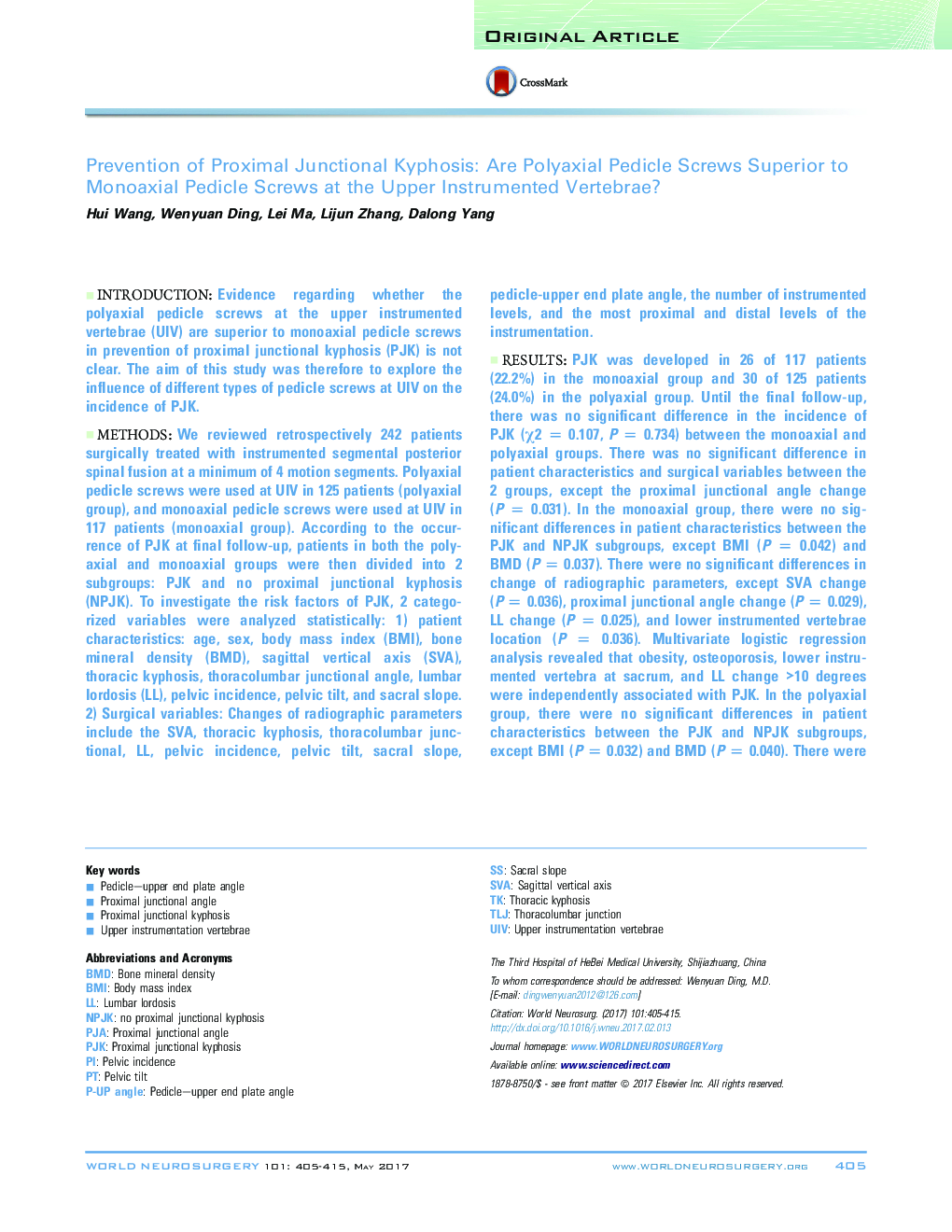| کد مقاله | کد نشریه | سال انتشار | مقاله انگلیسی | نسخه تمام متن |
|---|---|---|---|---|
| 5634122 | 1581454 | 2017 | 11 صفحه PDF | دانلود رایگان |

IntroductionEvidence regarding whether the polyaxial pedicle screws at the upper instrumented vertebrae (UIV) are superior to monoaxial pedicle screws in prevention of proximal junctional kyphosis (PJK) is not clear. The aim of this study was therefore to explore the influence of different types of pedicle screws at UIV on the incidence of PJK.MethodsWe reviewed retrospectively 242 patients surgically treated with instrumented segmental posterior spinal fusion at a minimum of 4 motion segments. Polyaxial pedicle screws were used at UIV in 125 patients (polyaxial group), and monoaxial pedicle screws were used at UIV in 117 patients (monoaxial group). According to the occurrence of PJK at final follow-up, patients in both the polyaxial and monoaxial groups were then divided into 2 subgroups: PJK and no proximal junctional kyphosis (NPJK). To investigate the risk factors of PJK, 2 categorized variables were analyzed statistically: 1) patient characteristics: age, sex, body mass index (BMI), bone mineral density (BMD), sagittal vertical axis (SVA), thoracic kyphosis, thoracolumbar junctional angle, lumbar lordosis (LL), pelvic incidence, pelvic tilt, and sacral slope. 2) Surgical variables: Changes of radiographic parameters include the SVA, thoracic kyphosis, thoracolumbar junctional, LL, pelvic incidence, pelvic tilt, sacral slope, pedicle-upper end plate angle, the number of instrumented levels, and the most proximal and distal levels of the instrumentation.ResultsPJK was developed in 26 of 117 patients (22.2%) in the monoaxial group and 30 of 125 patients (24.0%) in the polyaxial group. Until the final follow-up, there was no significant difference in the incidence of PJK (Ï2Â = 0.107, PÂ = 0.734) between the monoaxial and polyaxial groups. There was no significant difference in patient characteristics and surgical variables between the 2 groups, except the proximal junctional angle change (PÂ = 0.031). In the monoaxial group, there were no significant differences in patient characteristics between the PJK and NPJK subgroups, except BMI (PÂ = 0.042) and BMD (PÂ = 0.037). There were no significant differences in change of radiographic parameters, except SVA change (PÂ = 0.036), proximal junctional angle change (PÂ = 0.029), LL change (PÂ = 0.025), and lower instrumented vertebrae location (PÂ = 0.036). Multivariate logistic regression analysis revealed that obesity, osteoporosis, lower instrumented vertebra at sacrum, and LL change >10 degrees were independently associated with PJK. In the polyaxial group, there were no significant differences in patient characteristics between the PJK and NPJK subgroups, except BMI (PÂ = 0.032) and BMD (PÂ = 0.040). There were no significant differences in change of radiographic parameters between the PJK and NPJK subgroups, except P-UP angle (PÂ = 0.037) and lower instrumented vertebrae location (PÂ = 0.017). Multivariate logistic regression analysis revealed that obesity, osteoporosis, and lower instrumented vertebra at sacrum were independently associated with PJK.ConclusionsPolyaxial pedicle screws at UIV is not superior to monoaxial pedicle screws in prevention of PJK. Obesity, osteoporosis, and lower instrumented vertebra at sacrum are risk factors for PJK in all the patients. Excessive LL reconstruction is the unique risk factor of PJK when monoaxial pedicle screws were used at UIV.
Journal: World Neurosurgery - Volume 101, May 2017, Pages 405-415